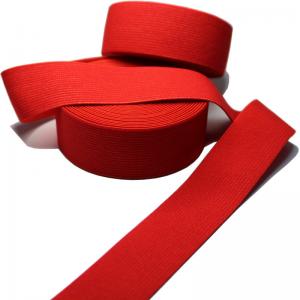Knitted 3cm Nylon Elastic Webbing Red Braided Loop Watch Band
Add to Cart
High Quality Braided Loop Strap Nylon Woven Fabric Elastic Band For Underwear
Product Features | ||
Product Name | Nylon Elastic Band | |
Material | Nylon Elastic Band | |
Tenchnic | Woven | |
Width | 3cm | |
Feature | Soft,High Tenacity | |
Color | Any Colors Can Be Made | |
MOQ | 3000 meters,we also make small trial orders | |
Usage | Garment, home textile, bag, etc. | |
Package | 1. Usually 50m/roll 2. Festoon packing 3.As your requirements | |
Payment | 30% T/T in advance, the balance paid against the B/L Copy or 100%
L/C at sight. | |
Delivery Time | 10 -15 days (depending on the order qty) | |
Shipment | By express (DHL, EMS, TNT,UPS, FEDEX)/by sea/air, etc. | |
FOB PORT | Shanghai,China | |
Quality Certification | Oeko-Tex | |
After-sales Service | We value after-sales service, we promise repairing, replacing and
refunding if there’s any quality problem of our products | |
Selection of Materials: The production begins with the selection of high-quality nylon fibers and elastic materials. Nylon is chosen for its strength and durability, while elastic materials like latex or spandex are added to provide stretchability.
Warping and Beaming: The nylon fibers are wound onto a large spool called a warp beam. Multiple strands of nylon fibers are arranged parallel to each other to create the desired width of the webbing. The warp beam is then mounted onto a weaving machine.
Weaving: The warp beam is loaded onto a weaving machine, which consists of a series of looms. The looms interlace the nylon fibers with the elastic material to form a woven webbing structure. The pattern and design of the webbing can be customized based on the desired end-use.
Dyeing and Finishing: Once the webbing is woven, it may undergo dyeing to add color. The dyeing process can be performed by immersing the webbing in dye baths or by using other dyeing techniques. After dyeing, the webbing may undergo finishing processes such as heat-setting, sizing, or coating to enhance its properties and durability.
Cutting and Sewing: After the webbing is dyed and finished, it is cut into the desired lengths and widths. The cut webbing is then sewn or attached to various fittings or fasteners, depending on its intended application. This may include sewing buckles, hooks, or other hardware onto the ends of the webbing to create functional straps or closures.
Quality Control and Packaging: The final step involves quality control checks to ensure that the webbing meets the required specifications and standards. This may include testing for strength, elasticity, colorfastness, and other relevant parameters. Once approved, the webbing is packaged and prepared for distribution or further manufacturing processes.
It's important to note that the specific production process may vary depending on the manufacturer, equipment used, and the desired characteristics of the nylon elastic webbing. Additionally, specialized machinery and techniques may be employed to create specific patterns, designs, or features in the webbing.




